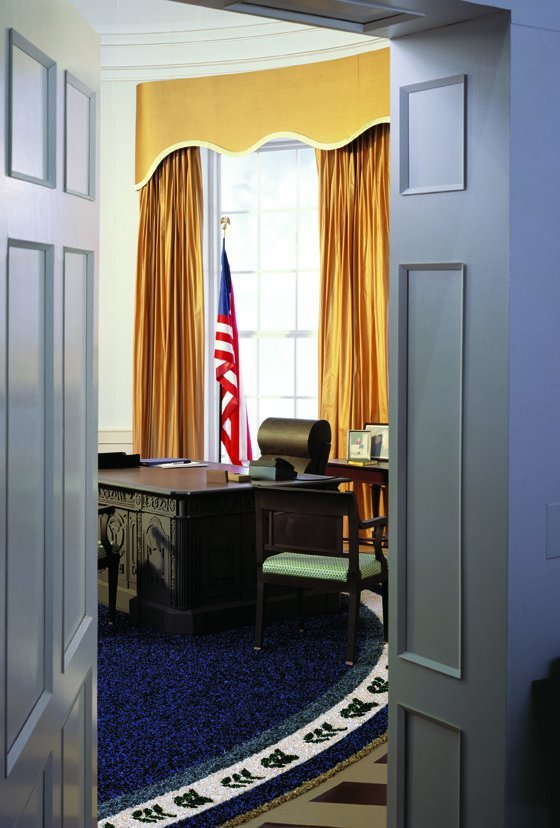Thomas Demand
dal 24/11/2008 al 16/1/2009
Segnalato da
24/11/2008
Thomas Demand
Monika Spruth Philomene Magers London, London
Demand's photography has long focussed on painstakingly detailed reenactments of specific and familiar places, public or private sites often loaded with social and political meanings. Following an invitation from the New York Times, the artist has created a timely and unnerving body of work which examines the literal and metaphorical seat of global power in the twenty-first century - the Oval Office in the White House, Washington, D.C.

Monika Sprüth and Philomene Magers are delighted to present the first solo exhibition of new work
by German artist Thomas Demand in the UK since his acclaimed Serpentine exhibition in summer
2006. Following an invitation from the New York Times, Demand has created a timely and
unnerving body of work which examines the literal and metaphorical seat of global power in the
twenty-first century – the Oval Office in the White House, Washington, D.C.
The Oval Office, the official workplace of the President of the United States of America, is one of
the most instantly recognisable interior locations in the world, its image a symbolic shorthand for the
exercise of ideological and geopolitical will. Yet Demand’s photographs, rather than capturing the
original Oval Office in all its formal opulence, instead depict a meticulously recreated life-size
model, fabricated from paper, cardboard and confetti. Each of the five images of this near-perfect
reconstruction of the most powerful room in the world is articulated through a complex
compositional language, making the reading of each photograph an aesthetically and conceptually
troubling experience.
Demand’s photography has long focussed on painstakingly detailed reenactments of specific and
familiar places, public or private sites often loaded with social and political meanings. His models
are highly detailed, yet they retain subtle but deliberate flaws and anachronisms to disrupt the
viewer’s comfort with the scene. This series also renders an immediately recognisable scene alien
through an innovative attention to perspective and formal composition. The oval shape of the Oval
Office is not usually a prominent feature of the multiplicity of images of this iconic space, yet in
Demand’s rendition, the eye is fascinated by it. Similarly, the viewer’s expectation is that this room
will be inhabited, either by politicians or actors pretending to be politicians, and that it will be
experienced on a human scale and at eye level. However, Demand’s Oval Office is conspicuous in
its human absence, an emptiness that is heightened by the ground-level and bird’s eye
perspectives from which the room is viewed.
The effect of Demand’s work has been to challenge any complacent assumptions about
photography’s claims to verisimilitude, and to complicate conventional notions of authenticity and
artifice. However, in the context of this new body of work, Demand’s practice gains an ever more
politicised momentum. Blurring boundaries between believability and pretence in the Oval Office
necessarily points to a critique of power as it has been wielded in the White House. Photographing
a near-exact replica of the US President’s office suggests intriguing connections between statecraft
and stagecraft, and the disposability of the construction materials (each of Demand’s models is
destroyed after it has been photographed) undermines any naïve faith in the permanence and
unshakeability of American, or indeed any, political authority.
This new exhibition marks a distinctive counterpoint to a number of Demand’s recent major works.
Tavern (2006), currently on view at Tate Modern, is, like this body of work, a suite of five images
which take a media-saturated location, in this case the site of a horrific murder in Germany, and
powerfully evoke a sense of ambivalence and the uncanny in how images of such memorable and
familiar places are received. It can also be viewed as a companion piece to Demand’s Embassy,
part of his presentation at the Fondazione Prada at Fondazione Giorgio Cini, in Venice in June
2007. Embassy centred on the reproduction, physically then photographically, of Niger’s consulate
in Rome, which was the ultimate destination of a trail of political intrigue involving the recent history
of nuclear proliferation, and the basis of America’s 2003 invasion of Iraq. These photographs depict
a highly politicised and geopolitically significant space, but one which was cluttered, dark, unknown
and locked away from view. This contrasts with Demand’s image of the Oval Office – an eerily airy
and instantly recognisable political environment which is defined by its public accessibility, and
whose image is so widely dispersed it looms ever-present in the collective visual vocabulary of
contemporary Western culture. The connection between the two works, in political and aesthetic
terms, is confirmed by the presence in these photographs of a framed image of a black figure that
appeared in Embassy. Not only does this intervention jar with the viewer’s visual expectation of the
Oval Office, but it reifies the problematic ways in which race, history and the Third World might be
located within the American political order.
Thomas Demand studied at the Düsseldorf Academy and Goldsmiths College. Solo exhibitions
include the first solo exhibition by a contemporary artist at the Museum of Modern Art, New York,
following its reopening in 2005, which was followed by an exhibition at the Serpentine Gallery in
London in 2006. Recent exhibitions include Fundación Telefónica, Madrid and the Hamburger
Kunsthalle, Germany. In 2004 he represented Germany at the Sao Paolo Biennale. Demand lives
in Berlin, and in 2009 he will have a major exhibition at the Neue Nationalgalerie in Berlin.
Private view: Tuesday 25 November, 6pm - 8pm
Monika Spruth Philomene Magers London
7/A Grafton Street - London
Opening hours: Tuesday – Saturday, 10am-6pm
Admission: Free



